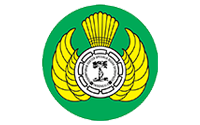BIOMECHANICAL COMPARATIVE STUDY BETWEEN TENSION BAND WIRING, DOUBLE ENDO BUTTON AND HOOK PLATE FOR ACROMIOCLAVICULAR JOINT INJURY
Downloads
Background: The treatment for acromioclavicular joint injury are debatable, there are fixation options include tension band wiring, AC joint reconstruction and hook plate These fixations are capable of providing a stable fixation, but controversy still exists that mentions the superiority of each of these fixations
Purpose: To compare biomechanical stability of 3 fixation include tension band wiring, double endo button, and hook plate to provide a scientific basis of the fixation.
Methods: This research is an experimental in vitro. Using 27 acromioclavicular joints cadaver divided into three groups that performed tension band wiring fixation, double endo button and hook plate. Each fixation evaluated with 10, 20, 50 and 100 times repetitions with 100N traction force.
Results: Tension band wiring gives the smallest displacement. In 10 times repetition average displacement of tension band wiring 0.056 mm (p = 0.000) compared to double endo button 1.622 mm and hook plate 0.867 mm. In 20 times repetitions, tension band wiring 0.1667 mm (p = 0,000) compared to double endo button 3.1778 mm and hook plate 1.1111 mm. In 50 times repetition, tension band wiring 0.3111 mm (p = 0.000) with double endo button 4.7778 mm and hook plate 1.3556 mm. In 100 times repetitions, tension band wire 0.556 mm (p = 0.000) while double endo button 5.4444 mm and hook plate 1.4556 mm.
Conclusion: Tension band wiring have a good stability compared to double endo button and hook plate. But all of fixation provide stability for acriomioclavicular joint motion.Emery R. 1997. Acromioclavicular and sternoclavicular joints. In: Copeland S, ed. Shoulder surgery. London: WB Saunders, 1997
Rockwood CA, Williams G, Young D. Disorders of the acromioclavicular joint. In: Rockwood CA, Matsen FA, eds. The shoulder. Second ed. Vol. 1. Philadelphia: WB Saunders, 1998:483-553
Webb J, Bannister G. 1992. Acromioclavicular disruption in first class rugby players. Br J Sports Med 1992;26:247-8
Pallis M, Cameron KL, Svoboda SJ, Owens BD. 2012. Epidemiology of Acromioclavicular Joint Injury in Young Athletes. Am J Sports Med 2012;40-2072
Kaplan LD, Flanigan DC, Norwig J, Jost P, Bradley J. 2005. Prevalence and variance of shoulder injuries in elite collegiate football players. Am J Sports Med. 2005;33(8):1142-1146
Yoon JP, Lee BJ, Nam JS, Chung SW, Jeong WJ, Min WK, Oh JH. Comparison of result between ook plate fixation and ligament reconstruction for acute unstable acromioclavicular joint dislocation. Clinics in Orthopedic Surgery 2015;7:97-103
Petersen W, Wellmann M, Rosslenbroich S, Zantop T. 2010. Minimally Invasive Acromioclavicular Joint Reconstruction (MINAR). Open Orthop Traumatol. 2010 Mar;22(1):52-61
Jambukeswaran PST, Senthilnathan, Prabhajar R. 2016. Comparison between two surgical technique acromioclavicular tension band wiring and acromioclavicular screw fixation in acromioclavicular dislocations. Int. J. Modn. Res. Revs. Volume 4, Issue 11, pp 1388-1391
Tossy JD, Mead NC, Sigmond HM. Acromioclavicular separations: Useful and practical classification for treatment. Clin Orthop Relat Res. 1963;28:111–9.
Mazzocca AD, Arciero RA, Bicos J. 2007. Evaluation and treatment of acromioclavicular joint injuries. Am J Sports Med 2007;35-2
Warth RJ, Martetschkager F, Gaskill TR, Millett PJ. 2012. Acromioclavicular joint separations. Curr Rev Musculoskelet Med (2013) 6:71–78
Kwon YW, Iannotti JP. 2003. Operative treatment of acromioclavicular joint injuries and results. Clin Sports Med. 2003;22:291-300.
McConnell AJ, Yoo DJ, Zdero R, Schemitsch EH, McKee MD. 2007. Methods of operative fixation of the acromio-clavicular joint: a biomechanical comparison. J Orthop Trauma. 2007 Apr; 21(4):248-53
Kumar N, Sharma V. 2015. Hook plate fixation for acute acromioclavicular dislocations without korakoklavikula ligament reconstruction: a functional outcome study in military personel. Strategies Trauma Limb Reconstr. 2015 Aug; 10(2): 79-85
Moodie JAF, Shortt NL, Robinson CM. 2008. Injuries to the acromioclavicular joint. J Bone Joint Surg [Br] 2008;90-B:697-707.
Li Xinning, Ma R, Bedi A, Dines DM, Altchek DW, Dines JS. 2014. Current Concepts Review; Management of Acromioclavicular Joint Injuries. J Bone Joint Surg [Am] 2014;96:73-84.
Browner BD, Jupiter JB, Krettek, Anderson PA. 2015. Skeletal Trauma: Basic Science, Management, and Reconstruction.
Sugathan HK, Dodenhoff RM. 2012. Management of type 3 acromioclavicular joint dislocation: Comparison of Long-Term Functional Results of Operative Methods. International Scholarly Research Network, 2012;580504-6
Benjamin M, Ralphs Jr, Shibu M, Irwin M. 1993. Capsular tissues of the proximal interphalangeal joint: normal composition and effects of Dupuytren's disease and rheumatoid arthritis. Journal of Hand Surgery 18B, 371-376
- The author acknowledges that the copyright of the article is transferred to the Journal of Orthopaedi and Traumatology Surabaya (JOINTS), whilst the author retains the moral right to the publication.
- The legal formal aspect of journal publication accessibility refers to Creative Commons Attribution-Non Commercial-Share Alike 4.0 International License (CC BY-NC-SA).
- All published manuscripts, whether in print or electronic form, are open access for educational, research, library purposes, and non-commercial uses. In addition to the aims mentioned above, the editorial board is not liable for any potential violations of copyright laws.
- The form to submit the manuscript's authenticity and copyright statement can be downloaded here.
Journal of Orthopaedi and Traumatology Surabaya (JOINTS) is licensed under a Creative Commons Attribution-Non Commercial-Share Alike 4.0 International License.



























